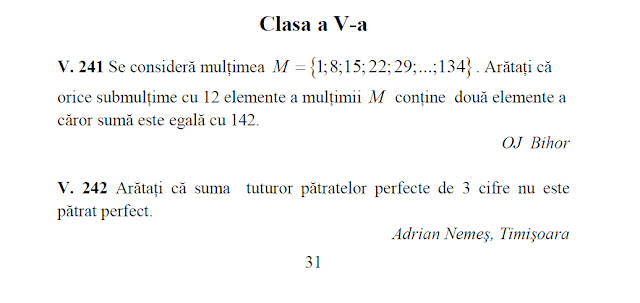I found an interesting problem, for class 5, in RMCS_39--2012.
In translation"V. 241 Consider the set $M=\{1,\;8,\;15,\;22,\;29, \dots ,\;134\}$. Show that any 12-element subset of the set M contains two elements whose sum is equal to 142.
Bihor County Olympiad"
I solve this problem with the help of the Pigeonhole principle. A post on AOPS also helped me.
First note that since $1=7\cdot 0+1,\;8=7\cdot 1+1,\;15=7\cdot 2+1,\dots ,\;134=7\cdot 19+1$, the set M has 20 elements. Let's arrange the elements of the set M on 10 columns like this
$$\begin{array}{|r|r|}\hline 8&15&22&29&36&43&50&57&64&1 \\ \hline 134&127&120&113&106&99&92&85&78&71 \\ \hline \end{array}$$
The sum of the elements in the first nine columns is 142. Let us choose some set of 12 elements from the elements of the set M. Let's assume that, in the worst case, we also chose elements 1 and 71 (from the last column). However, 12-2=10 elements remain. With only nine columns available, two of the ten elements must be in the same column, and they will have the sum 142.
$\blacksquare$
Remark CiP There are sets with 11 elements that do not satisfy the requirement of the problem. For example
$$\{1,\;8,\;15,\;22,\;29,\;36,\;43,\;50,\;57,\;64,\;70\}.$$
L.E. You can also consult the solution from RMCS here, at page 19.
Other issues of the RMCS can be found here.

Niciun comentariu:
Trimiteți un comentariu